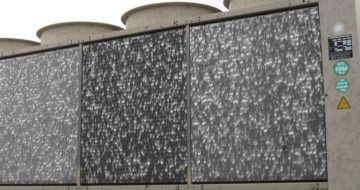
April 9, 2018 in Advisory Notes
Managing Resilient Buildings - Preparing for Dust Storm...
It is important particularly during the drier months in Australia to plan for extreme weather events such as dust storms.
November 21, 2017
Heat waves are a regular extreme weather event in Australia. With respect to building air conditioning systems this is commonly thought of as two or more days when the ambient temperature exceeds the maximum temperature that the building and its systems were designed for.
During a heat wave, buildings rely on any excess capability in the air conditioning system to provide acceptable internal temperatures. When the demand for cooling surpasses this capability, internal temperatures can rise beyond comfortable levels.
Although tenancy leases may not require the maintenance of specific internal temperatures, this is usually expected, misunderstandings arise and importantly tenants become dissatisfied with the building’s performance. This is sometimes more of an issue in higher quality grade buildings where there is a raised expectation around Indoor Environmental Quality standards.
Older buildings tend to have greater spare air conditioning capability ‘designed in’ compared to new buildings. The closely designed air-conditioning systems in newer buildings generally cope less well with heat wave conditions although this can be offset by better building ‘insulation’ standards.
The extra load placed on air conditioning systems during extreme heat events results in increased energy consumption and may cause the contracted maximum electrical supply demand level to be exceeded, triggering ongoing electricity supply charge penalties.
Often the worst of these events follow a very warm weekend when the building’s air-conditioning hasn’t been running. Internal air temperatures and the temperature of the building’s internal ‘fabric’ are elevated before the Monday morning start.
With recent improvements in weather forecasting, heat waves can now usually be reliably anticipated 4-5 days in advance.
Modern Building Management and Control Systems (BMCS) can be pre-programed with control strategies to pre-empt heat wave conditions. These can manage the operation of air conditioning plant to achieve improved internal conditions whilst reducing the effect on energy consumption and avoiding potential maximum demand penalties.
Heat wave BMCS strategies can be activated either automatically by the presence of pre-established conditions (e.g. time-temperature profiles and internal conditions) or manually by the Facility Management team in line with a pre-determined activation plan (e.g. based on weather forecast information and internal conditions).

Air-conditioning control strategies to pre-empt heat wave events can include combinations of the following:
The particular strategies and their combination depend upon the thermal performance characteristics of the subject building and its air conditioning systems – the combination of the building physics and the building systems. The understanding of this interrelationship is the key to achieving optimal performance during heatwave conditions. Developing successful strategies is an iterative exercise with an initial approach optimised based on the review of performance data.
These strategies can result in significant improvements in internal conditions during heatwave events and substantial avoided energy costs.
Extreme weather events have become more common and severe. For more information on preparing buildings for a changing climate please also read the Advisory Note: Managing Resilient Buildings for a Changing Climate.
download pdf
April 9, 2018 in Advisory Notes
It is important particularly during the drier months in Australia to plan for extreme weather events such as dust storms.

April 10, 2015 in Advisory Notes
As the effects of climate change become more evident, it is apparent that facilities and their operation need to adapt. Built environments must become...